U.S. DEFENDERS SURRENDER WAKE ISLAND TO JAPANESE
Wake Island, North Pacific Ocean · December 23, 1941
On this date in 1941 Wake Island defenders surrendered after two attack waves of 1,000 Japanese each stormed the beaches. Two days earlier, in their largest attack yet on Wake Island, the Japanese had sent 49 aircraft, dive bombers and fighters both, to knock out the last of the island’s eight aircraft—this after launching their first air assault (36 bombers) on December 8, five hours after their surprise attack on Pearl Harbor, Hawaii. (Wake was on the opposite side of the International Date Line.) Three days later, on December 11, 450 Japanese marines attempted their first landing. They were repulsed by U.S. Marine Corps shore batteries and Grumman F4F Wildcats, which shot down 24 Japanese aircraft and sank two Japanese destroyers—the first two Japanese warships lost in World War II. Wake Island, a U.S. Pacific outpost between Hawaii and Guam, had been identified as a “priority defense requirement” four months before August 1941, the month building the island’s defenses began. By December, Wake had become the most heavily defended U.S. atoll in the Pacific. A week after Pearl Harbor, a U.S. relief force, which included a carrier with 117 aircraft and 13 destroyers, steamed toward Wake from Hawaii. When the Japanese successfully assaulted the island on December 23, the relief force was still 425 miles away. After eleven hours of fierce resistance, the Japanese captured roughly 450 sailors, Marines, and soldiers and 1,150 civilian-contractor volunteers, the majority beginning 3‑1/2 years of captivity as slave laborers in China and Japan. POWs who remained on the island were employed by the Japanese in building island defenses: concrete and coral block houses and pillboxes with interlocking fire, tank traps, land mines, and barbed-wire entanglements along the shoreline, aircraft revetments at the airfield, etc. In September 1942 a second batch of POWs was transported to prison camps in China. The 98 heavy equipment operators who remained were executed in early October 1943 when the Japanese garrison feared an imminent invasion from a U.S. armada that included the carrier USS Yorktown and many cruisers and destroyers. The garrison, numbering 4,400 army and navy personnel at its height, remained entrenched on Wake Island through September 4, 1945, surrendering to a detachment of U.S. Marines two days after their nation’s formal surrender in Tokyo Bay.
[amazon_carousel widget_type=”ASINList” width=”600″ height=”200″ title=”Recommended Reading” market_place=”US” shuffle_products=”False” show_border=”False” asin=”0933126395,0553585673,0803295626,1849086036,157488736X,1612001297,0451212053,1591148995,1591141753,0786710969″ /]
Battle of Wake Island, December 8–23, 1941
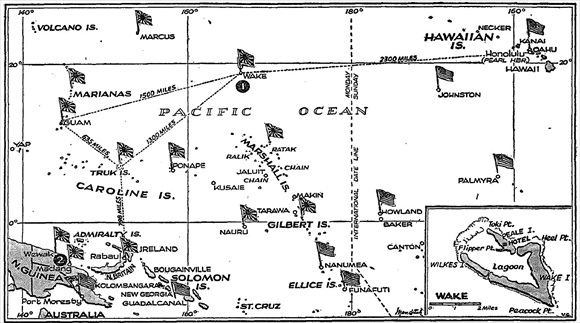 |
Above: Map of the Pacific, circa early 1943. Japanese-occupied Wake Island is located in the center of the map above the black circle enclosing a “1.” To the east of Wake Island the Pacific outposts are in American hands. Japanese island strongholds lie to the west of Wake and much of the south; e.g., the Marianas, Guam, and the Marshall and Gilbert islands, which the Americans took during campaigns that lasted from November 1943 through August 1944.
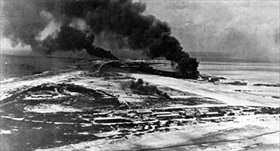 | 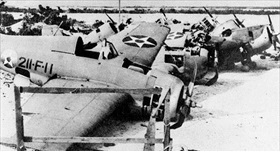 |
Left: Columns of smoke rise from on either side of Wake Island’s airstrip after a Japanese air attack in December 1941.
![]()
Right: Just hours after the attack on Pearl Harbor, 36 Japanese bombers flown from bases on the Marshall Islands attacked Wake Island, destroying 8 of the 12 F4F‑3 Wildcat fighter aircraft belonging to Marine Corps fighter squadron VMF‑211 on the ground. This photo shows the wreckage of Wildcat 211‑F‑11, flown by Capt. Henry T. Elrod on December 11, 1941, in the attack that sank the Japanese destroyer Kisaragi. Elrod was posthumously awarded the Congressional Medal of Honor—the first aviator to receive the medal in World War II—for his actions on the island during the second Japanese landing attempt on December 23.
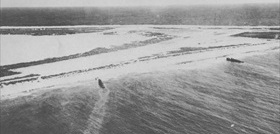 | 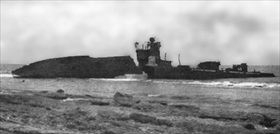 |
Above: Japanese Patrol Boat No. 32 and Patrol Boat No. 33 were two ex-destroyers reconfigured in 1941 to launch a landing craft carrying a detachment of sailors over a stern ramp. In the photo on the left the two patrol boats (Patrol Boat No. 32 on the left) have been run aground on the south shore of Wake Island near the airstrip early on the morning of December 23, 1941. Island defenders, with a 3‑in gun, drew a bead on beached Patrol Boat No. 33, 300 yards from their position. Some of their projectiles touched off the ship’s magazine, and the warship began to burn. (Her remains are shown in the right photo.) The illumination provided by the burning ship revealed her sister ship, Patrol Boat No. 32, which was hit with 5‑in coastal artillery guns. Twenty-five minutes later that boat too was completely demolished.
Radio Broadcast Announcing Fall of Wake Island to Japanese
![]()

 History buffs, there is good news! The Daily Chronicles of World War II is now available as an ebook for $4.99 on Amazon.com. Containing a year’s worth of dated entries from this website, the ebook brings the story of this tumultuous era to life in a compelling, authoritative, and succinct manner. Featuring inventive navigation aids, the ebook enables readers to instantly move forward or backward by month and date to different dated entries. Simple and elegant! Click
History buffs, there is good news! The Daily Chronicles of World War II is now available as an ebook for $4.99 on Amazon.com. Containing a year’s worth of dated entries from this website, the ebook brings the story of this tumultuous era to life in a compelling, authoritative, and succinct manner. Featuring inventive navigation aids, the ebook enables readers to instantly move forward or backward by month and date to different dated entries. Simple and elegant! Click 











